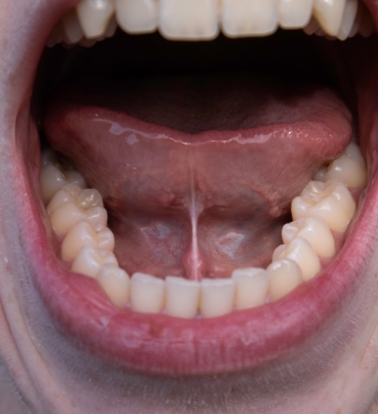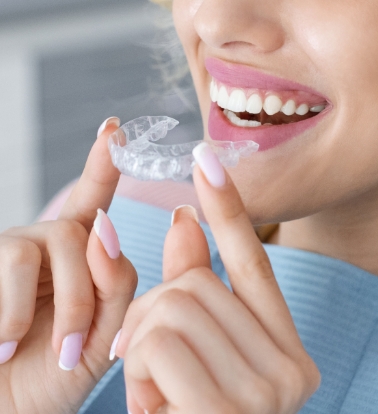
What is Temporomandibular Joint Disorder?
Temporomandibular joint disorder (TMD) refers to a group of related disorders that result from problems with the jaw or jaw joint, or facial muscles involved in jaw movement. TMD and Facial pain can become a pain that you learn to live with as a day-to-day occurrence. It most often presents as a chronic pain but can demonstrate with an occasional acute flare-up. These disorders are often incorrectly referred to as TMJ, which refers only to the temporomandibular joint itself.
What is the Difference Between TMJ and TMD?
It’s basically acronym table tennis. Most dental practices aren’t versed in temporomandibular joint disorder. But of those that do understand and treat this condition, some practices use TMJ, others TMD. To us at Broadway Family Dentistry TMJ stands for the temporomandibular joint. The disorder of a misaligned jaw is temporomandibular joint disorder, hence TMD.
What Are the Symptoms of TMD?
- Chronic facial pain in the face, jaw, neck, and shoulders
- Chronic facial pain in or around the ear
- Limited ability to open the mouth wide
- Difficulty chewing
- Uncomfortable bite
- Swelling on one or both sides of the face
- Clicking or popping noises when opening the mouth
- Headaches and neck aches
These symptoms may arise from any number of easily identifiable and treatable causes, including sinus infections, tooth decay or gum disease.
What Are the Causes of TMD?
Although there are many causes of TMD, muscles and the neuro-muscular relationship to the teeth are often the primary reason for this debilitating pain. Obtaining muscular physiologic rest is the beginning treatment for resolving these symptoms.
Common causes include:
- Trauma to the head or neck
- Oral habits such as clenching or grinding of the teeth
- “Bad” bite or missing teeth
- Arthritis
- Malalignment of the upper and lower jaws
What Are the Treatment Used for TMD?
At Broadway Family Dentistry, we employ a variety of approaches when treating patients suffering from TMD. These can run from relaxation exercises at home to anti-inflammatory medications, from traditional dental work to creating a splint for nighttime use. Sometimes, it’s a process of trial and error; we’ll try a certain approach and if it doesn’t have the desired effect, we’ll move to the next option.
These are some of the methods we use to help our patients overcome TMD:
- Cosmetic dentistry — To correct alignment, we can replace missing teeth with dental implants or bridges, crown overly worn teeth, or move the teeth with orthodontics. This can involve widening constricted arches.
- Splints or night guards — Night grinding and clenching is often a main factor in TMD. To combat this, it’s important to put the jaw in the correct position at night. To do this, we fabricate plastic mouthpieces that fit over the upper and lower teeth. These are usually worn at night.
- Medication — Muscle relaxants and anti-inflammatory medication can be effective.
- Lifestyle changes — Stress and anxiety are often root causes; stress reduction techniques are important.
- Transcutaneous electrical nerve stimulation (TENS) — Small electrical pulses are delivered to the jaw muscles through a small wand. These pulses stimulate the nerves, encouraging the muscles to relax and the jaw to fall into alignment.
What Happens if TMD Goes Untreated?
In North Dakota, we pride ourselves on being a tough lot. Thirty below zero in January? No biggie. But leaving TMD untreated isn’t a good idea. The chronic pain you’re experiencing because the work your temporomandibular jaw is doing trying to reach alignment won’t stop. Chronic pain is the main component of TMD — pain in your jaws, mouth, teeth, ears, neck, shoulders, and head. Chronic pain leads to depression, alcoholism, addiction to pain medication, and a diminished daily existence. Many TMD sufferers grind their teeth while they sleep, a condition known as bruxism. Left unattended, this leads to cracked and damaged teeth, and usually is accompanied by insomnia. Ear problems such as tinnitus are another result of TMD, as can be inner ear problems leading to problems with vertigo. The continued pressure on your misaligned jaw can lead to permanent jaw damage, including possible jaw locking or jaw dislocation due to damaged cartilage.
What Can I Expect After My TMD is Treated at Broadway?
Once we are able to return your jaw to proper alignment, you’ll be amazed at how much better you feel. The pain and tenderness in your face, jaw, neck and shoulders, and around your ears will calm and resolve. The headaches that are common with TMD should drop dramatically in their frequency. Tinnitus should improve unless it is due to other issues. That perpetual fatigue, occasional dizziness, all of the symptoms that you couldn’t understand should all improve once your jaw no longer has to struggle to try and find proper alignment.
If you are experiencing jaw pain and you live in Minot, Williston, Garrison, New Town, Rugby, Bismark or Devils Lake, ND, give Broadway Family Dentistry a call at 701-839-1299 or fill out a Contact Form here.








